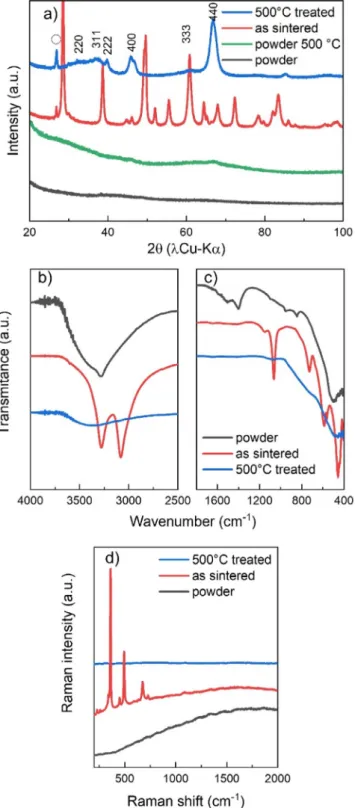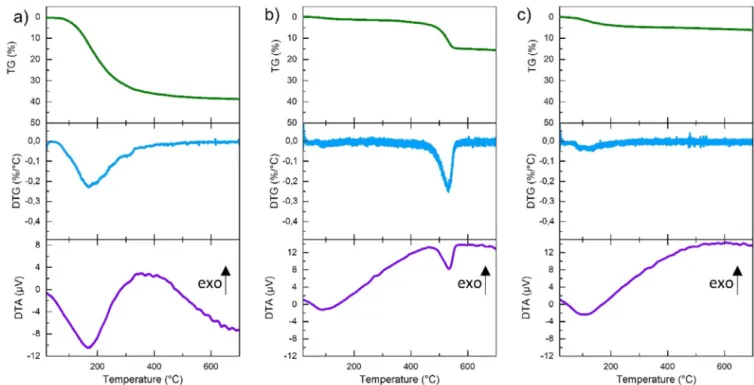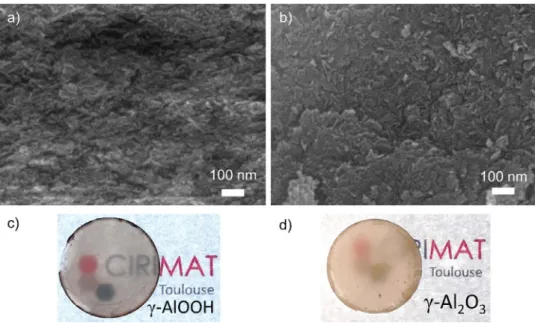HAL Id: hal-03100689
https://hal.archives-ouvertes.fr/hal-03100689
Submitted on 6 Jan 2021
HAL is a multi-disciplinary open access
archive for the deposit and dissemination of
sci-entific research documents, whether they are
pub-lished or not. The documents may come from
teaching and research institutions in France or
abroad, or from public or private research centers.
L’archive ouverte pluridisciplinaire HAL, est
destinée au dépôt et à la diffusion de documents
scientifiques de niveau recherche, publiés ou non,
émanant des établissements d’enseignement et de
recherche français ou étrangers, des laboratoires
publics ou privés.
Translucent γ-AlOOH and γ-Al2O3 glass-ceramics using
the cold sintering process
Thomas Hérisson de Beauvoir, Claude Estournès
To cite this version:
Thomas Hérisson de Beauvoir, Claude Estournès.
Translucent γ-AlOOH and γ-Al2O3
glass-ceramics using the cold sintering process.
Scripta Materialia, Elsevier, 2020, 194, pp.113650.
OATAO is an open access repository that collects the work of Toulouse
researchers and makes it freely available over the web where possible
Any correspondence concerning this service should be sent
to the repository administrator:
tech-oatao@listes-diff.inp-toulouse.fr
This is an author’s version published in:
https://oatao.univ-toulouse.fr/27025
To cite this version:
Hérisson de Beauvoir, Thomas and Estournès, Claude Translucent
γ-AlOOH and γ-Al2O3 glass-ceramics using the cold sintering
process. (2020) Scripta Materialia, 194. 113650. ISSN 1359-6462
Open Archive Toulouse Archive Ouverte
Official URL :
Translucent
γ
-AlOOH
and
γ
-Al
2
O
3
glass-ceramics
using
the
cold
sintering
process
Thomas
Hérisson
de
Beauvoir
∗,
Claude
Estournès
CIRIMAT, CNRS-INP-UPS, Université Toulouse 3 – Paul Sabatier 118 route de Narbonne, F-31062 Toulouse cedex 9, France
a
r
t
i
c
l
e
i
n
f
o
Keywords: Sintering Ceramics Aluminaa
b
s
t
r
a
c
t
ColdSinteringProcesshasbeenappliedtohydroxideprecursorsAl(OH)3,xH2Otopromoteinsitureactive
sintering.Theapplicationofsinteringtemperatures<400°CledtothereleaseofOHgroupsandpartial crystallizationintoboehmite γ-AlOOH.Thislatterstepisaccompaniedbyadensificationstageleading totheproductionofdensetranslucentpellet.Fromskeletaldensitymeasurements,itappearsthatnotall thepelletiscomposedofcrystallinephase,butcontainsamixofamorphousandcrystallinephase.The presenceofamorphousphaseseemstofavorthemechanicalstabilityofthesamplesmadeofthe inter-mediateboehmitephase,whichisbrittleduetoitsorientedlayerstructure.Furtherheattreatmentinan ovenat500°Cinducesthetransformationofboehmiteintoγ-Al2O3.Herewedemonstratethepossibility
toproduceopticallytranslucentceramicsoflowtemperaturestabilitygammaaluminastructure.
Therecentdevelopmentofcoldsinteringtechniqueshasshown agreatefficiencyinthepreparationofdensesamplesatextremely low temperatures[1–3].The processisgenerallyassumedto pro-ceedthroughapressuresolutioncreepmechanismachievedunder uniaxialhighpressure(typically>100MPatoGParange)andmild temperatures(<500°C). Althoughitappearsthatsintering mech-anismsinduce adissolutionstepfollowed byaprecipitation step, their precise descriptionis not provided yet [4]. This way,dense bulk materials wereobtainedinvarious chemicalmedia. Amajor challenge concerns materials with very low solubility in the ex-perimental conditions(typically < 400°C underuniaxial pressure 100-800 MPa[5,6]). Todensify such materials, alternative strate-gieshavebeendeveloped,showingsuccessfulresults.Ionic liquid was usedto densify BaTiO3 inthe absence ofwater, with
densi-tiesreaching98% oftheoreticaldensityattemperaturesaslow as 300°C without further heat treatment [7]. Another solution con-sists inactivatingsintering througha decomposition-reactive sin-tering.Following thisroutelead tothepreparationofpure zirco-nia fromhydroxide precursors Zr(OH)4 in just a few minutes at
350°C [8]. Recent work on BaTiO3 from Ba(OH)2, 8H2O
precur-sors also showed high densification rate (95 % relative density) without formation of BaCO3 [9]. This route offers a great
poten-tialforthepreparationofmetaloxides fromlowtemperature de-composinghydroxides. Moreover,thisalsooffersopportunitiesfor
∗Corresponding author.
E-mail address: herisson-de-beauvoir@chimie.ups-tlse.fr (T. Hérisson de Beau- voir).
the preparationof dense materials withvery low decomposition temperatures [10] such as sulfates [11], carbonates [5,12], phos-phates[13,14]butalso oxides [6]. Aluminarepresents one ofthe mostusedoxidematerial,especially underthemoststablephase
α
-Al2O3. It also presentsa large subset of metastable crystallinephases(
γ
,δ
,θ
,κ
,ε
,η
,χ
)[15].Amongaluminacrystallinephases,γ
-Al2O3isofparticularinterestforcatalystsupportapplication.Itslackofstabilitymakesitdifficulttodensifyintomonolithic
ceram-ics. However, densification could be performed under extremely
highpressure, at3 GPa- 500°C usinga specific design [16]. An-other possibilityfor
γ
-Al2O3 is touseitto promotedensificationof
α
-Al2O3phasethroughaphasetransformationenhancedsinter-ing[17,18].
HereweproposetousetheColdSinteringProcessstartingfrom
hydrated Al hydroxide to obtain dense samples of AlOOH with
boehmite structure, which can further be heat treatedto obtain samplesofpure
γ
-Al2O3phase.Cold Sintering was performed on commercial Al(OH)3, xH2O
(SigmaAldrich)powderinaWCdieatvarioustemperatures rang-ing from 150°C to 400°C under 500 MPa uniaxial pressure, for dwelltimesbetween30and180min.After thedwelltime, tem-perature wasnaturallydecreased to room temperatureand pres-surewasslowlyreleasedover45mintoavoidpelletcracks.Some sinteredsampleswere heattreatedat500°Cfor2hunderairina conventionalfurnace.
XRDpatternswere recordedontheasreceivedAl(OH)3,xH2O
powder andtreatedat 500°C for2h aswell ason adense sam-ple sinteredat380°C andsubsequently annealed at500°C inair.
Fig. 1. a) XRD patterns of starting Al(OH) 3 , H 2 O powder, 380 °C sintered pellet and
500 °C treated pellet, b-c) corresponding FTIR spectra in ATR mode and d) cor- responding Raman spectra (O symbol in XRD represents graphite signature and
γ-Al 2 O 3 Miller indices are indicated above the corresponding peaks [25] ). See
Fig. 3 for boehmite peak positions.
As displayed on Fig. 1a, both the asreceived and 500°C treated powdersdisplaynocrystallizedphase.However,inthecaseof sin-tered sample, although the sintering temperature is only 380°C, crystallization occurred inducing theformation of pure boehmite
γ
-AlOOHphase. Aftera 500°Ctreatmentinan oven,thesintered pellet’s structure changes toγ
-Al2O3 phase, withno trace ofre-maining boehmitephase.Toconfirm thistransition, FTIRand
Ra-manspectroscopicmeasurementswereperformed.FTIRresultsare displayed on Fig. 1b-c. As received powder spectrum presents a broadpeakaround 500cm−1,associatedwithtwo peaksat1400 and1510 cm−1,whichare typical signatureofAl(OH)3 [19,20].A
broadpeakfrom2700to3700cm−1 confirmsthepresenceof wa-ter molecules in thepowder, witha sharper peak at 3280cm−1 denotingthe presenceof linked OH groupsinthe structure.FTIR
pattern of sintered sample shows a sharp doublet at 3280 and
3080 cm−1, resulting from boehmite stretching mode of AlO-H, associatedwitha doublet at1080at 1160cm−1 forAl-OH bend-ingmode[21,22].Thethreesharppeaksobservedat730,600and 480 cm−1 can be attributedto Al-O6 stretching modes [22]. For
the 500°C heatedpellet, onlya broad contributionfrom 3000 to 3700 cm−1 anda largepeak at500 cm−1 are observed, confirm-ingthetotalabsenceofAlOOH,thereforeconfirmingthecomplete transition to
γ
-Al2O3 as observed in XRD. Fig. 1d displaysRa-manspectraofthesamesamples.WhileAlOOHhasactivemodes
inRaman, both Al(OH)3 and
γ
-Al2O3 haveno activemodes [23].Thismakes thetechniquea great tool to evaluate the total tran-sitionfrom AlOOH toAl2O3. As displayedhere, onlythe sintered
sample displays bands at 360, 450 and 495 cm−1, assigned to
Al-O vibrationalmodes, aswell as730 and674 cm−1 which can be assigned to
γ
(OH) vibrational modes [24]. These bandscon-firm the boehmite structure of AlOOH phase. After heat
treat-ment of this sample at 500°C, no more active band is detected ontheRamanspectrum,confirmingthetotalphasetransformation into
γ
-Al2O3.According to these results, it is clearly evidenced that cold sinteringprocess at temperaturesbelow400°Cinduces transition fromamorphousAl(OH)3tocrystallized
γ
-AlOOHwhileasshownbytheXRDthestartingpowderremainsamorphousevenafter an-nealingat500°C.
Forthesethreesamples(powder,assinteredpellet and500°C treatedpellet) thermalanalysiswere performed fromroom tem-perature to 700°C and are presented in Fig. 2. Starting powder showsamassivelossof38wt.%from30to350°Cwhichis asso-ciatedtothe removalofH2Omolecules.Thisallows todetermine
thecompositionofthepowderasAl(OH)3,0.5H2O.DTA
measure-mentshowsanendothermicpeakusually associatedtothe dehy-dration[26].Nofurtherthermaleventisobservedathigher tem-perature up to 700°C. The “as sintered” (Fig. 2b) pellet shows a first mass loss of 4.7wt.% from room temperature to 200°C fol-lowedby a second loss of 16wt.% up to 600°C.The first loss is attributedto adsorbed water on the pellet, eitherresulting from theincompletewaterremovalalongsinteringexperiment,oreven from rehydration at room temperature after sintering in the re-maining porosities.Thesecond loss,associatedwithan endother-micpeakinDTA,isassignedtothecrystallizationofboehmiteinto
γ
-Al2O3 (asobservedinXRDatFig.1).Thisisconsistentwiththeexpected17wt.%lossfromthereaction2AlOOH →Al2O3 + H2O
inthe formofH2Omolecules.Forthesampleheat treated2hat
500°C(Fig.2c),afirstloss isobservedfromroomtemperatureto 200°C associatedwiththe presence ofwater, whichmust be
ad-sorbed fromthe atmosphere, asconfirmed by the presence of a
broadpeak in FTIR (see Fig.1b). However, up to800°Cno more lossisobserved,anddifferentialthermalanalysisconfirmsthe ab-sence ofthe AlOOH → Al2O3 phase transition, as expectedfrom
XRD,RamanandFTIRanalyses.
Fig.3apresentstheevolutionofskeletaldensityofsamples sin-teredatvarioustemperatures, andmeasured ina Hepycnometer oncrushedpellets.Initially,theasreceived powderhasaskeletal densityof 2.16 g.cm−3 (represented by the point at 20°C) which slightlyincreasesafter a150°C sintering,reaching 2.21 g.cm−3.A more drasticincrease of the densityoccursfrom 350°C to 400°C witha density of 3.05g.cm−3 at400°C,which is the theoretical densityofpure
γ
-AlOOH[27].Fig. 2. Thermogravimetric and differential thermal analyses of a) powder, b) sintered pellet and c) 500 °C treated pellet.
Fig. 3. a) Density measurements obtained from He pycnometer on crushed sintered pellets and b) XRD patterns of samples sintered at various temperatures.
XRD patterns ofsamples sintered atvarious temperatures are displayed on Fig. 3b. At 125°C, small broad peaks are evidenced which are the first signature of the genesis of a crystallization phenomenon. Above this temperature, from 150°C to 400°C, the peak intensity increases progressively up to 400°C with sharper peaks, indicating that crystallization has continued and/or that crystal size increases with sintering temperature. As a confirma-tion, crystallite sizes, obtained fromScherrer equation applied to
XRDFWHMdataindicateanaveragesizeevolution from3nmto
18 nm forsintering temperatures of150 and 400°C respectively.
He pycnometry measurements, alongwithXRD patterns,indicate
that theformation of boehmiteprogressively occursfrom150 to 400°Cfromthe amorphousAl(OH)3,0.5H2Opowder, both visible
intheXRDpeakwidthandskeletaldensityincrease.Sincetheonly phaseformingduringsinteringisAlOOH(havingatheoretical den-sity of 3.05 g.cm−3) and skeletal densityfor samples sintered in therange150°C<T<380°Cisprogressivelyincreasing,stillbelow
that ofAlOOH,it meansthey are composedofmixedamorphous
Al(OH)3 and crystallized AlOOH. This progressive evolution from
amorphoustocrystallizedphaseoccurringupto400°Callows pro-ducingsampleswithmixedcompositionofcontrolledcrystallinity. This is an important asset of the present work since the prepa-ration ofmechanicallycoherent boehmitepellet is madedifficult dueto the layered structuralnature [27],making it brittle. Thus, theresultingpelletsaftersinteringmostoftenbreak,by delamina-tion,dueto pressurerelease.Thisis whya carefulslowpressure release is necessary to preserve the mechanical cohesion of the sample.Inthecaseofsamplessinteredattemperatureslowerthan 400°Cleadingtoapartialcrystallizationofthesamplepermitsthe preparationofcohesivesamples.Itappearsthatthepresenceofan amorphousphaseallowsforastressabsorptioninthesample,and thereforeallowstopreparecohesivesamples.
Furthermore, we know from XRD patterns in Fig. 1 and
Fig. 4. SEM images of fractured surfaces of a) as sintered and b) 500 °C annealed pellet. Photos of the corresponding samples are shown in c) sintered pellet and d) 500 °C treated.
2h allows the complete phase transformation of
γ
-AlOOH toγ
-Al2O3, but does not allow the crystallization of Al(OH)3. Thus,whiletheAlOOHphasepresentinsinteredsamplestransforminto Al2O3 afterheat treatment,thetemperatureistoolow to
crystal-lizetheamorphousphaseandtheresultingpelletmustbeamixed amorphous-crystallizedphase.
Fig. 4 a and b display SEM micrographs of both the sintered boehmite pellet and the heatedsintered
γ
-Al2O3 fracturedsam-ples. First, one cannotice thevery smallgrain size ofboth sam-ples,withsizesbelow100nm.Assinteredsample(380°C)consists inneedle-likegrains,withanaverage10nmwidth,50nmlength. Applying the Scherrer formulaonthe XRDpatternofthe sample sinteredat380°Cgivesanaveragecrystallitesizeof3.7nmwhile the sample sintered at 400°C showsa crystallite size of 5.5nm. Thesecrystallite sizesare inthesamerangeastheone foundfor ZrO2 sintered in SPS at 350°C from Zr(OH)4 and determined by
HR-SEM andPair Distribution Function [8]. As mentioned earlier, as sintering temperature is increased, transition fromAl(OH)3 to
AlOOH progressively occurs and translucency increases concomi-tantly.Therefore,producinghighlytranslucent,mechanicallystable ceramicsrequirestofindabalancebetweenamorphous/crystalized phases.
Boehmitephase isawell-known precursorforthepreparation of
γ
-Al2O3 with a phase transition expected at 500°C [15] andobserved inDTA(see Fig.2b).OnFig.4b,
γ
-Al2O3 microstructurestill containssome elongated grains, which must come fromthe initial AlOOH phase,but mostof themexhibit nospecific shape. Theiraveragesizeispreservedsinceitreaches30nm.Thisphase transition consists in a topotactic transition with no lattice size modification [25,28].Thus, itis possibleto preservethe mechan-ical integrity ofthe samplewithoutbreaking it duringthephase transition.
Using Aluminum hydroxide precursor allows the
densifica-tion at temperature ≤ 400°C of boehmite phase
γ
-AlOOH. Thisdensification occurs witha temperature dependent glass-ceramic
composition evolution, both conferring the optical properties
and ensuring the mechanical strength of the sample. Due to
the topotactic phase transition existing between
γ
-AlOOH andγ
-Al2O3 attemperatureas low as500°C,it is possibleto obtaindense samplesof pure
γ
-Al2O3.The presentworkrepresentsthefirst known exampleofa cold sinteredsamplewith goodoptical
translucency. Moreover,it isa great exampleofthepossibility to preserve very low grain sizesalong sintering withaverage grain sizes below 50 nm after sintering. In addition, the preparation
of glass-ceramic materials opens new opportunities in tuning
propertiesandoffersatooltocontroldensificationandsintering. ColdSinteringProcessallowsforthefirsttimethepreparation ofadensesampleofpure
γ
-Al2O3,ametastablephasethateasilyturnsto
α
-Al2O3 whenheateduptotemperaturesof1000-1100°Cafterintermediatephase transitionsthrough
δ
(700-800°C)andθ
(900-1000°C) [15].Dueto thevolume shrinkageinduced by such phase transition, one must expect crackandpore formation. Ob-tainingdenseα
-Al2O3thereforeimpliestoproceedthroughsingle step route to avoidtheseproblems. However, the presentresults opensupopportunitiesinthepreparationoftransitionaluminaas sintereddenseorporoussamples.γ
-Al2O3,whichisoftenusedforitshighspecificsurfacearea,isagreatcandidateforthecold sin-teringofporousmaterialsandshowstheabilityofColdSintering Processtoapplyinthefieldofcatalyticandopticalapplications.
DeclarationofCompetingInterest
Theauthorsdeclarethattheyhavenoknowncompeting finan-cialinterestsorpersonalrelationshipsthatcouldhaveappearedto influencetheworkreportedinthispaper.
References
[1] J. Guo , R. Floyd , S. Lowum , J.-P. Maria , T. Herisson De Beauvoir , J.H. Seo , C.A. Randall , Annu. Rev. Mater. Res. 49 (2019) 275–295 .
[2] M.T. Sebastian , H. Wang , H. Jantunen , Curr. Opin. Solid State Mater. Sci. 20 (2016) 151–170 .
[3] C. Vakifahmetoglu , L. Karacasulu , Curr. Opin. Solid State Mater. Sci. 24 (2020) 100807 .
[4] M. Biesuz , G. Taveri , A.I. Duff, E. Olevsky , D. Zhu , C. Hu , S. Grasso , Adv. Appl. Ceram. 119 (2019) 75–89 .
[5] F. Bouville , A.R. Studart , Nat. Commun. 8 (2017) 14655 .
[6] S.H. Bang , T. Herisson de Beauvoir , C.A. Randall , J. Eur. Ceram. Soc. 39 (2019) 1230–1236 .
[7] K. Tsuji , A. Ndayishimiye , S. Lowum , R. Floyd , K. Wang , M. Wetherington , J. Maria , C.A. Randall , J. Eur. Ceram. Soc. 40 (2019) 1280–1284 .
[8] C. Elissalde , U.C. Chung , M. Josse , G. Goglio , M.R. Suchomel , J. Majimel , A. Weibel , F. Soubie , A. Flaureau , A. Fregeac , C. Estournès , Scr. Mater. 168 (2019) 134–138 .
[9] T. Sada , K. Tsuji , A. Ndayishimiye , Z. Fan , Y. Fujioka , C.A. Randall ,J. Eur. Ceram. Soc. (2020) .
[10] T. Herisson de Beauvoir , A. Sangregorio , I. Cornu , C. Elissalde , M. Josse , J. Mater. Chem. C 6 (9) (2018) 2229–2233 .
[11] T. Herisson de Beauvoir , F. Molinari , U.C. Chung-Seu , D. Michau , D. Denux , M. Josse , J. Eur. Ceram. Soc. 38 (2018) 3867–3874 .
[12] T. Herisson de Beauvoir , A. Sangregorio , I. Cornu , M. Josse , Dalt. Trans. 49 (2020) 7820–7828 .
[13] H. Nakaya , M. Iwasaki , T. Herisson de Beauvoir , C.A. Randall , J. Eur. Ceram. Soc. 39 (2019) 396–401 .
[14] T. Herisson de Beauvoir , A. Sangregorio , A. Bertrand , C. Payen , D. Michau , U.-C. Chung-Seu , M. Josse , Ceram. Int. 45 (2019) 9674–9678 .
[15] I. Levin , D. Brandon , J. Am. Ceram. Soc. 81 (1998) 1995–2012 .
[16] F. Balima , F. Bellin , D. Michau , O. Viraphong , A. Poulon-Quintin , U.C. Chung , A. Dourfaye , A. Largeteau , Mater. Des. 139 (2018) 541–548 .
[17] C. Bousquet , C. Elissalde , C. Aymonier , M. Maglione , F. Cansell , J.M. Heintz , J. Eur. Ceram. Soc. 28 (2008) 223–228 .
[18] F. Balima , A. Largeteau , Scr. Mater. 158 (2019) 20–23 .
[19]Y. Zhang , J. Binner , J. Mater. Sci. Lett. 21 (2002) 803–805 .
[20]M.A. González-Gómez , S. Belderbos , S. Yañez-Vilar , Y. Piñeiro , F. Cleeren , G. Bormans , C.M. Deroose , W. Gsell , U. Himmelreich , J. Rivas , Nanomaterials 9 (2019) 1626 .
[21]V. Saraswati , G.V.N. Rao , G.V. Rama Rao , J. Mater. Sci. 22 (1987) 2529–2534 .
[22]M.C. Stegmann , D. Vivien , C. Mazieres ,Spectrochim. Acta Part A Mol. Spectrosc. 29 (1973) 1653–1663 .
[23]A. Aminzadeh , Appl. Spectrosc. 51 (1997) 817–819 .
[24]H.D. Ruan , R.L. Frost , J.T. Kloprogge , J. Raman Spectrosc. 32 (2001) 745–750 .
[25]X. Krokidis , P. Raybaud , A.E. Gobichon , B. Rebours , P. Euzen , H. Toulhoat , J. Phys. Chem. B 105 (2001) 5121–5130 .
[26]Z.Y. Deng , T. Fukasawa , M. Ando , G.J. Zhang , T. Ohji , J. Am. Ceram. Soc. 84 (2001) 4 85–4 91 .
[27]R.J. Hill , Clays Clay Miner. 29 (1981) 435–445 .


